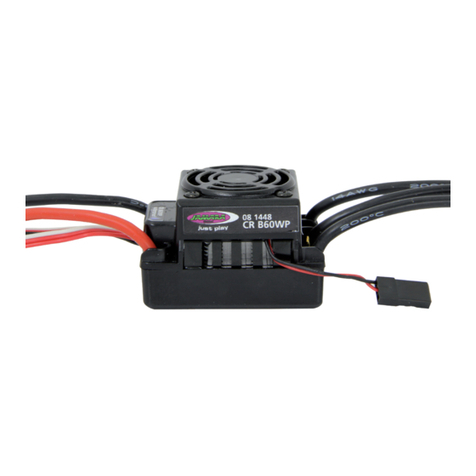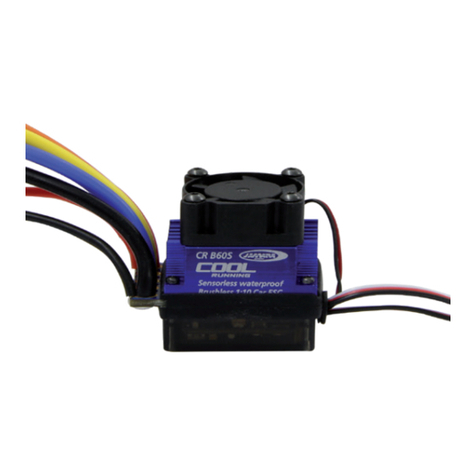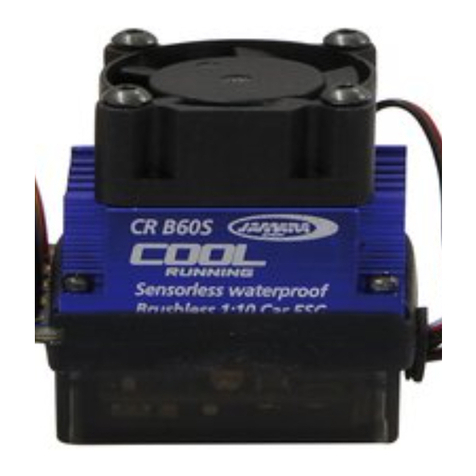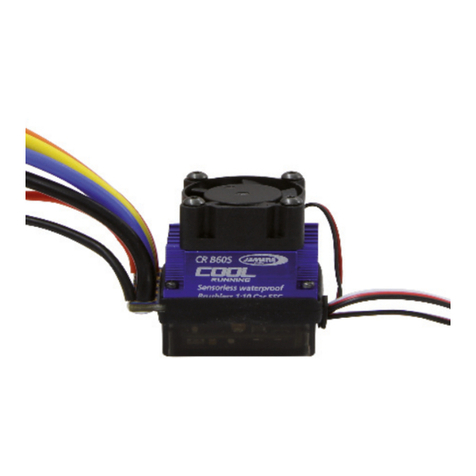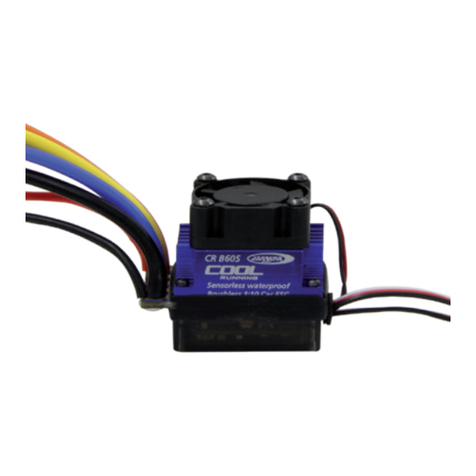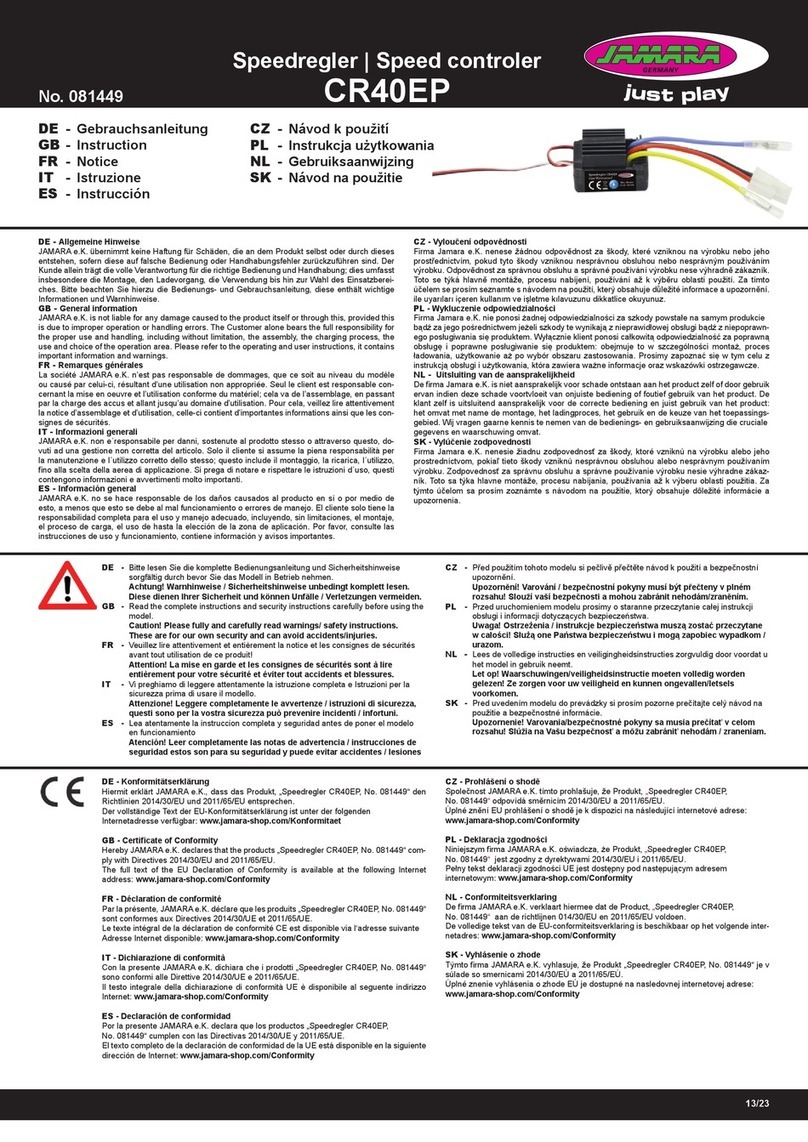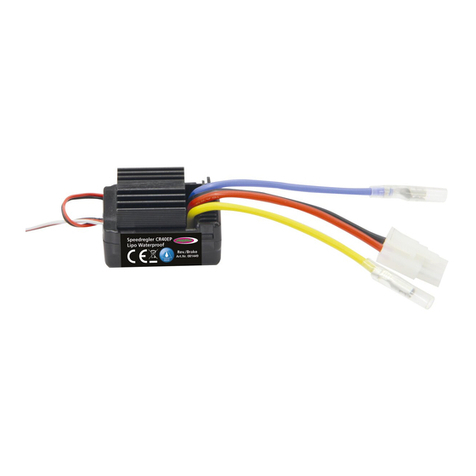
IT - L´uso della scheda di programmazione
(disponibile opzionalmente)
1. La scheda di programmazione CR con LED Display fa
diventare l´uso più facile e confortevole. Tutte le impostazioni
del regolatore sono direttamente segnate sul display della
scheda.
2. Accendere il regolatore e collegate il cavo con la scheda di
programmazione (Attenzione sulla direzione d’inserimento) e
aspettare ca. 2secondi nche si attiva il display della
scheda. Il primo passo di programmazione viene indicato a
sinistra. Se non viene visualizzato nulla, controllare
l´inserimento della scheda e ripetere il processo.
3. Se il regolatore non è collegato a una batteria, la scheda
deve essere anche collegato a una batteria. (5 - 6,3V)
(Attenzione alla polarità corretta ).
4. Premere il pulsante “Menu” e ruotare a piacimento tra i
varie passi di programmazione, premendo nuovamente il
pulsante. Scelto l´operazione desiderata, potete cambiare i
valori premendo il pulsante . “Value” I valori sono indicati sul
lato destro del display. Ogni cambiamento va memorizzato
premendo il pulsante „OK“. Anche quando si spegne il
regolatore, i cambiamenti rimangano memorizzato nella
memoria.
5. Tramite il pulsante “Reset” vecchie impostazioni possano
essere ripristinate.
GB - Using CR Program card (optional)
1. The Program card with LED display is easy to use and
convenient to carry. All of the programmable functions are
shown on the program card.
2. Turn on the ESC. Remove the Signal wire and plug it into the
top-socket on the Program card , wait for 2 seconds until the
LED is ON.
The rst programmable function will be shown, if an error oc
curs, please reconnect them.
3. If ESC is not connected with the batteries, the Program card
should be connected with other power supply, the range of
power supply is within 5.0-6.3V.
4. Press the button “Menu” on the Program card and circularly
select each programmable function. At that time the number
of the programmable function will be displayed on the left of
the LED, the current value will be displayed on the right side.
Then press the button Value to change the value and press
the button OK to conrm. At the same time the Red indicating
LEDs of both program card and the ESC blink. Turn off the
ESC, the modied settings will be saved in the ESC’s
memory.
5. Press the button Reset to restore the default settings.
IT - Sicurezza
Quando si collega un motore elettrico alle batterie, si può causare
la partenza involontaria del motore. Inoltre, i motori elettrici collegati
a batterie di trazione, a causa di difetti meccanici o tecnici possono
improvvisamente partire. Anche se la ricevente funziona in autonomia
dalla trasmittente spenta, il motore può avviarsi in modo imprevisto.
Ciò potrebbe causare gravi lesioni.
Pertanto, nessuno deve trovarsi nella zona di pericolo, come quella
interessata da parti di un’elica rotante. Assicurarsi che nessun ogget-
to possa entrare in contatto con gli elementi in rotazione. I sistemi ad
alta potenza possono essere molto pericolosi! Correnti elevate, sono
in grado di surriscaldare la batteria e i cablaggi. Questo può causare
incendi o bruciature alla pelle.
I regolatori sono stati progettati esclusivamente per essere utilizzati
con batterie. Non collegare mai il regolatore a un dispositivo di
rete. Proteggere il regolatore di giri da vibrazioni, polvere, umidità
e pressioni meccaniche. Non esporlo a zone estremamente calde
o fredde. Prendere in considerazione le indicazioni del costruttore
delle batterie. Dopo danni alle batterie controllare il regolatore a in-
tervalli regolari. Non apportare modiche al regolatore. Questo vale
anche per i cavi di connessione batteria che non possono essere per
nessun motivo allungati.
Gli attacchi della batteria non sono protetti dall‘inversione di polari-
tà. Seguire le istruzioni di cablaggio! Se le connessioni della batteria
vengono invertite, il regolatore può essere danneggiato in modo irre-
parabile. I cavi di collegamento sono colorati. Collegare il cavo rosso
al polo positivo e il nero a quello negativo della batteria. Qualora il
motore girasse in senso inverso, scambiare semplicemente due cavi
del motore per ottenere il senso giusto. Non invertire mai le polarità
della batteria.
Per la messa in funzione del sistema, mettere in atto anche
le seguenti precauzioni:
• Mettere solo batterie entro i limiti tecnici consigliati.
• Lasciare raffreddare bene il regolatore prima di rimetterlo in
funzione.
• Rimuovere la batteria dal modello dopo ogni utilizzo.
• Attivare necessariamente sempre prima la trasmettente e poi la
ricevente, allo spegnimento del sistema, procedere in senso
inverso.
• Utilizzare solo cavi e connettori di alta qualità.
• Creare un buon condotto di raffreddamento per il regolatore,
non avvolgerlo per alcun motivo con gommapiuma o simili.
GB -Safety and operating instructions
When connecting an electric motor can cause the unwanted starting
of the engine. Moreover, is it possible that electric motors with
connected power pack can start suddenly because of mechanical or
technical defects. This may cause serious injury.
Because of that it is not allowed that someone is in the near of the
dangerous area around the rotating parts. Take care that no objects
can come in contact with the rotating components of the power drive.
High current can heat up battery, cables and connectors. There may
be re or burns to the skin.
Always use a battery pack to operate the speed controller, never use
a wall power supply. Protect the controller against vibration, dust, mo-
isture and mechanical stress. It neither cold nor excessive
heat from. Consider the specications of the manufacturer of the used
Batteries. Check the controller at regular intervals for damage. At the
regulator may no changes are made. This also applies to the battery
cable, which may in no case extend.
The battery of the controller ports are not protected against reverse
polarity. If the battery connections are reversed, the controller may
be damaged beyond repair. The connecting cables are color coded.
Connect the red to the positive terminal and the black to the negative
terminal of the battery. If the motor runs, it can by swapping two motor
connections, the direction is changed. Never reverse the battery con-
nections, leading to the destruction of the controller.
For the operation of the controller, observe the following safety
instructions:
• Only batteries within the limits of the technical data of the speed
controller. Please note the dates of the corresponding chapter of
this manual.
• Let the controller after use cool well before you start again.
• Remove the battery from the aircraft after each use .
• Turn necessarily on the transmitter rst and then the receiver.
For turn off you go in reverse order.
• Use only high quality cables and connectors.
• Ensure good cooling of the regulator, wrap it in no way a foam
rubber or the like. The attached heat sink must be absolutely
free and are circulated well in air.
7
